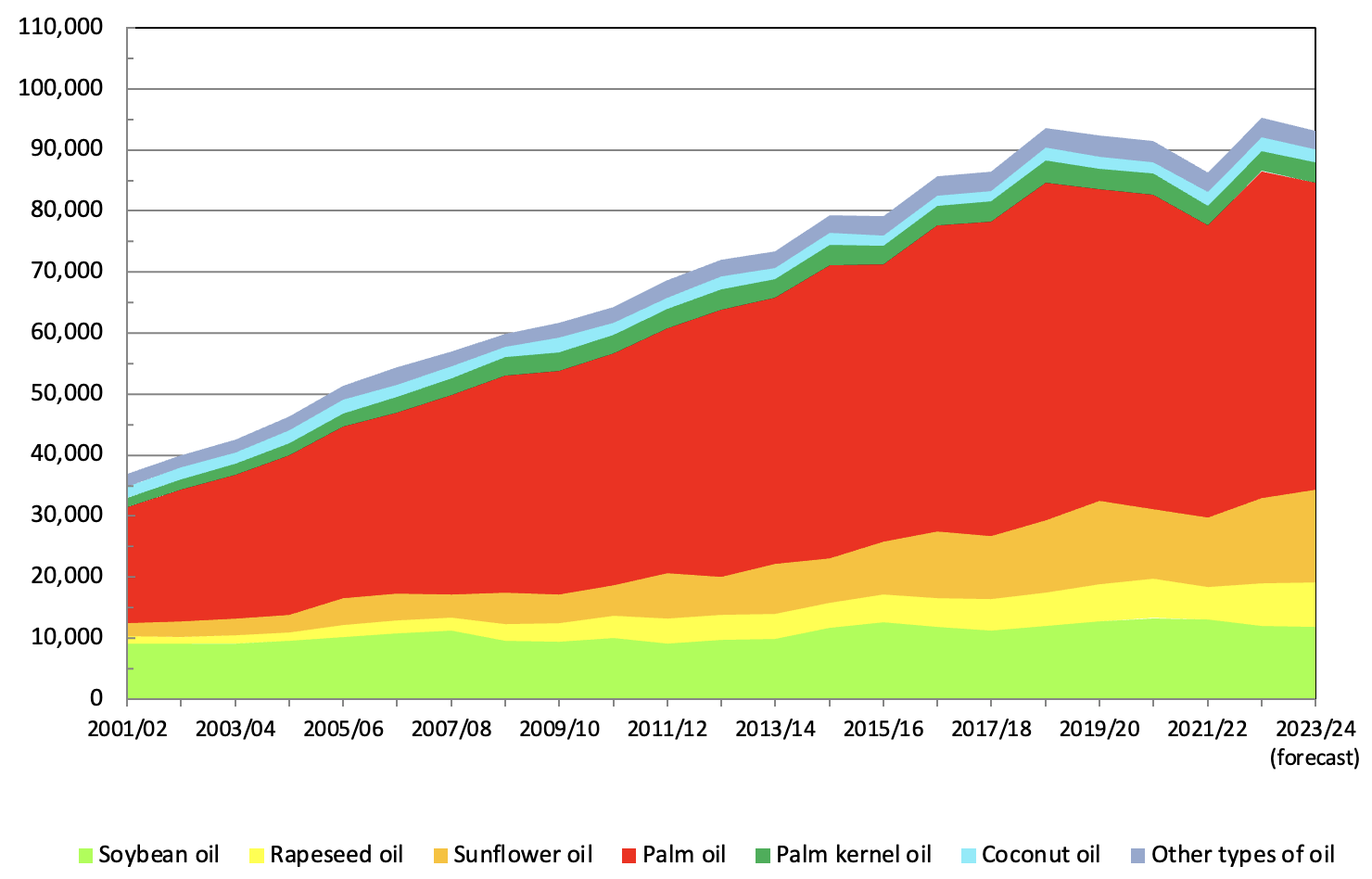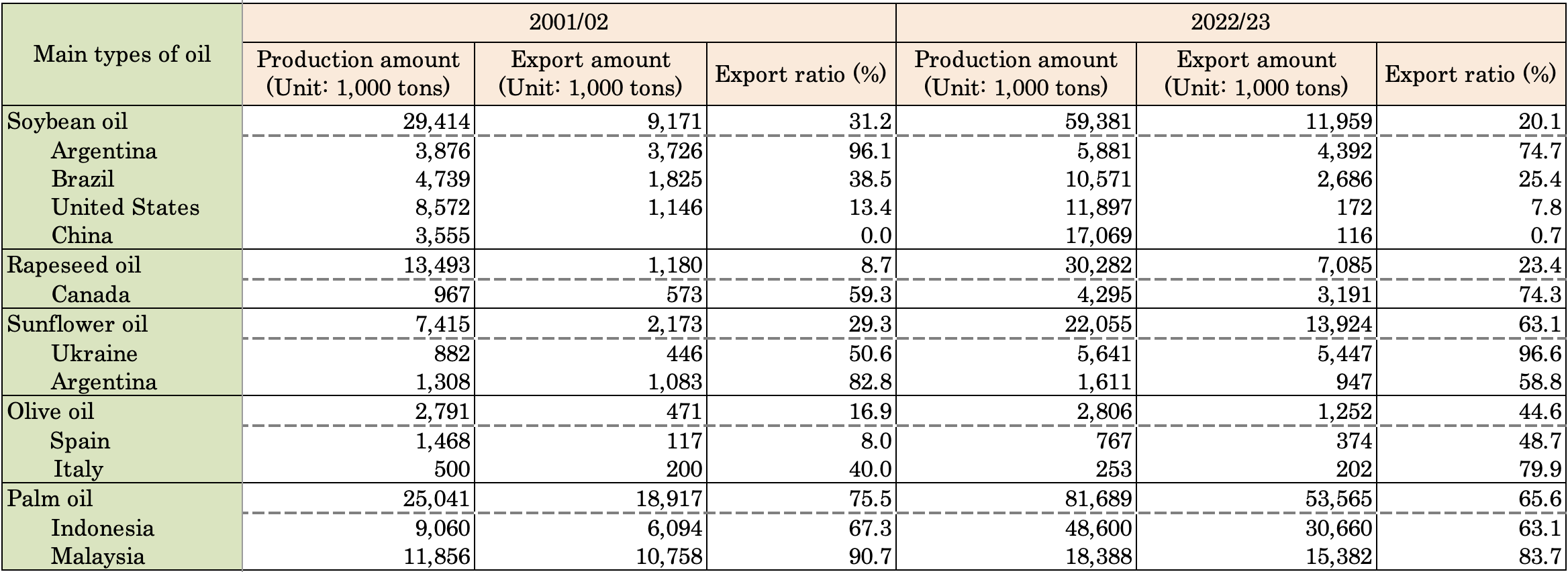The international trading amount (export amount) of vegetable oil continues to increase every year. As shown in Figure 7, the amount expanded to slightly less than 2.5 times between 2001-2002 and 2023-2024 (forecasted). Due to factors such as the impact of COVID-19, the amount decreased from the previous year to 91.47 million tons in 2020-2021 and 86.32 million tons in 2021-2022. However, the amount recovered to 95.31 million tons in 2022-2023 and is forecasted to reach 93.23 million tons in 2023-2024. This amount is more than 40% of the vegetable oil production amount.
Three types of oil account for more than 60% of the global trading amount: palm oil, palm kernel oil, and coconut oil. These three types are collectively referred to as "tropical oil." Soybean oil, which is second only to palm oil in terms of production amount, only accounts for about 10% of the trading amount. In the case of soybean oil and other vegetable oil that is made from oilseed, trading mainly takes place in the form of seeds which are the raw material and oil is usually produced in the country of consumption. Conversely, palm oil and other oils made from fruit pulp can only be distributed internationally in the form of oil. This causes the discrepancy in trading amounts.
When examining the ratio (2022-2023) for the export amount in relation to the production amount for each type of oil, palm oil has a ratio of 66% as oil intended for export. In contrast, when examining soybean oil and other oil made from oilseed, soybean oil has a low export ratio of 20%. This ratio shows that, generally speaking, expression and production is mainly performed in the country of consumption.
Figure 7: Changes in export amount for main vegetable oil
(Unit: 1,000 tons)

Source: Same as Figure 1
Note: "Other types of oil" is the total of cottonseed oil, peanut oil, corn oil, sesame oil, olive oil, linseed oil, and castor oil.
Practically speaking, the two countries of Malaysia and Indonesia are export countries for palm oil, which has the highest export amount. This includes palm kernel oil which is an associated product. These two countries have grown palm oil-related industries by positioning the industry as an important national industry. As a result, the countries have achieved a production amount that greatly exceeds domestic demand. This excess amount is allocated for exporting. In Malaysia, 84% of the produced amount is exported. However, Indonesia has a big population that consumes a large amount of domestic palm oil consumption. Consequently, the ratio allocated for exporting is 63% (2022-2023).
Similar trends can be seen in soybean oil. In order, the three largest producers of soybean oil are the United States, Argentina, and Brazil. Conversely, for the trading amount, when excluding China, the order is Argentina, Brazil, and the United States. Based on its history as the "breadbasket of the world," the United States fulfills its obligation of exporting soybeans. On the other hand, Argentina (a soybean developing nation) is using discriminatory tax policy to promote the exporting of soybean oil and soybean meal instead of soybeans themselves. As shown in Table 4, almost all of the soybean oil produced in Argentina in 2001/02 was allocated for exporting. Previously, Brazil also had a discriminatory export tax policy similar to Argentina. However, in the mid-1990s, Brazil revoked its discriminatory export tax policy and entered a trend similar to the United States.
One a different topic, the exporting of rapeseed oil is dominated by Canada. Previously, Canada concentrated on the exporting of rapeseeds due to its small domestic expression capacity. However, during the past 10 years, Canada has increased its domestic expression capacity and has strengthened its resolve to export rapeseed oil.
Among oil obtained from seeds, sunflower oil has a relatively high export ratio. In particular, Ukraine, a country located in the granary of Europe, actively produces sunflower seeds and other seeds, and is working to increase exports.
Table 4: Changes in vegetable oil production and exports in main exporting countries

Source: Same as Figure 1
Note: In some cases, oil produced in the previous year is allotted to exports. Therefore, production and exports may not match for the same fiscal year.




